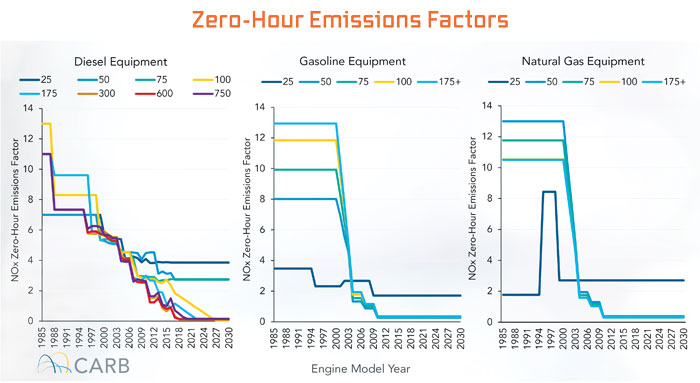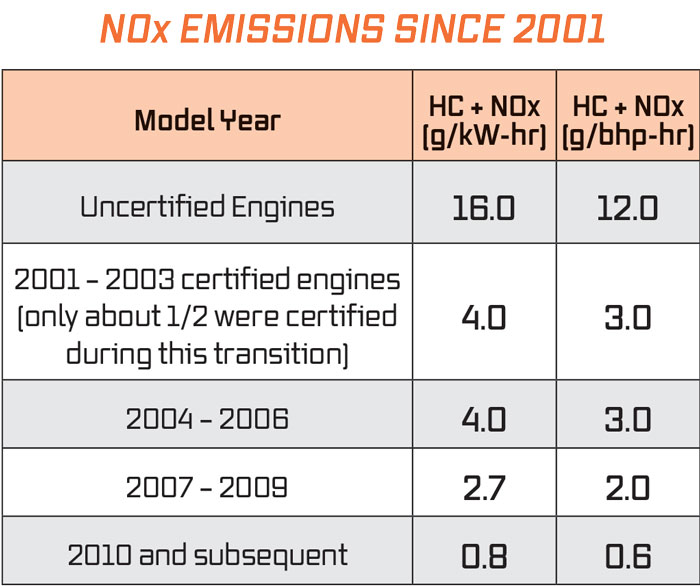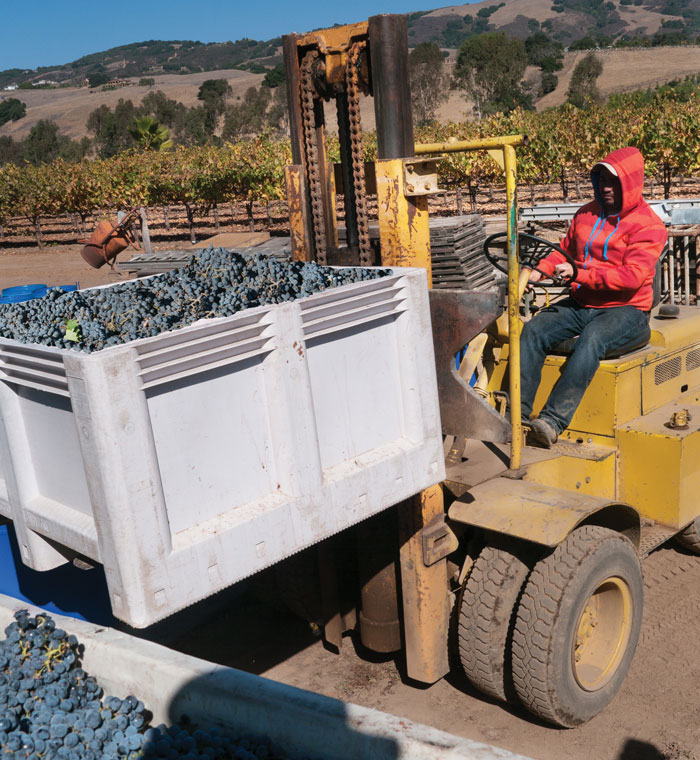Editor’s Note: Farm Equipment asked Joani Woelfel, president and CEO of the Far West Equipment Dealers Assn., to provide subscribers with an update on what is happening in California and what could extend to other areas. FWEDA represents dealers in Arizona, California, Colorado, Hawaii, Nevada, Utah and Wyoming and is an affiliate of Equipment Dealers Assn. (EDA).
The California Air Resources Board (CARB) is fast-tracking mandates to electrify all mobile industry sectors in the state, citing California Gov. Gavin Newsom’s executive order from September 2020 that ramped up timelines for vehicle and equipment sales to be “zero emissions” by 2045 “where feasible.”
The order states:
“It shall be a goal of the State that 100% of in-state sales of new passenger cars and trucks will be zero-emission by 2035. It shall be a further goal of the State that 100% of medium-and heavy-duty vehicles in the state be zero-emission by 2045 for all operations where feasible and by 2035 for drayage trucks. It shall be further a goal of the State to transition to 100% zero-emission off-road vehicles and equipment by 2035 where feasible.”
In prompt response, CARB and California legislators passed rules banning sales of new gas-powered, small off-road equipment (SOREs) starting in 2024. Equipment dealers say there are applications where electric equipment is neither feasible nor cost effective despite CARB’s efforts to eliminate on- and off-road combustion engines.
Priorities Amiss in Nation’s Largest Ag Economy
According to the USDA’s last census, California’s 70,521 farmers led the nation in ag sales at $45.2 billion, roughly 12% of the entire U.S. and $16 billion more than the next nearest state.
At a May 6 meeting in Visalia, Calif., more than 350 San Joaquin Valley farmers, business owners and local elected officials detailed for legislators and California’s Secretary of Agriculture Karen Ross how the state’s water crisis is threatening the country’s largest ag economy. They said environmental policies and inaction on water supply for crops is resulting in the loss of 1 million acres of the country’s most fertile farmland, a portion of which is being replaced with wind and solar farms to advance the state’s transition to electrification.
In a letter to CARB, the California Landscape Contractors Assn. (CLCA) disputed the AB 1346 bill sponsor saying new commercial-grade electric, zero-turn riding mowers are priced at $15,500-$37,000-plus. In most cases, this amount is “more than double the upfront cost of comparable gas-powered equipment.” This does not include the cost of purchasing and installing the charging infrastructure.
“Commercial grade handheld products have similar cost concerns,” the letter continues. CLCA said a popular model electric string trimmer that’s priced similarly to the manufacturer’s gas-powered unit does not include the up-front cost of extra batteries and chargers required to power the trimmer for an entire day, driving expenses to exceed $1,000. “Once the cost of gas vs. electricity is factored in, even for those who can afford the initial increased cost, these costs are currently not recoverable over the life of most commercial-grade equipment.”
Andrew Bray, vice president of government relations for the National Assn. of Landscape Professionals, provided perspective to the Los Angeles Times. Bray showed that the $30 million the bill pledges to help commercial businesses switch to electric equivalents would provide just $600 to each of the estimated 50,000 businesses in the state.
‘Disproportionate to Benefits’
CARB acknowledges clean-air rules have reduced carbon emissions by 90% since 1967. Equipment experts say targeting gas engine bans on equipment that contributes less than a tenth of the remaining 10% is so costly it’s drastically disproportionate to any benefit.
CARB is pushing for Tier 5 engine standards for off-road equipment such as tractors. Equipment manufacturers say the greatest year-over-year price increases for tractors coincided with implementing Tier 4 requirements. In 2021, the state reported that farm equipment in the San Joaquin Valley, which contributes an estimated 22% of emissions, is less than 30 years old. The state’s Funding Agricultural Replacement Measures for Emission Reductions (FARMER) program incentivizing upgrades to Tier 3-4 equipment is increasing these models to 50% of the tractor population, with Tier 4 Final (Tier 4F) making up 39% of the total.
“Incentives have been successful in introducing Tier 4F equipment much faster than projected in the 2011 inventory, where it was projected that 15% would be Tier 4F in 2024,” according to the report.
Sights Set on Forklifts
Forklifts, a significant offering for California dealers, offer a glimpse into the complexities of electrification and mandates. CARB is drafting regulations to ban the sale of new large-spark ignition (LSI) forklifts with up to 12,000-pound lift capacity starting in 2026. According to a 2017 CARB-sponsored study prepared by California State Univ.-Fullerton, Class IV and V forklifts affected by the proposed rules represent 58% — or 227,000 — of the state’s forklifts.

This CARB April 2022 Equipment Emissions Inventory shows a dramatic decrease in emissions across all forklift engine classes over the past 40 years.
Looking at the entire food chain distribution (field to processing to retail markets) experts estimate that up to 50% of the state’s LSI forklifts are associated with ag and food production.
The rule would also significantly limit LSI rentals and leasing and would require retiring LSI forklifts 13 years and older starting in 2026 regardless of their useful life, with an expectation of being fully electric by 2038.

CARB engine emissions standards are more stringent than EPA standards for 2010 and later.
Source: CARB
Equipment dealers and ag groups say the rules’ impact would be staggering. They add that mandates are unnecessary since the transition to electric is happening organically as CARB itself acknowledged in its April 2022 LSI emissions inventory.
The CSU-Fullerton report estimates 79,000 forklifts are now electric. As shown in the table above, dealers point out that since model year 2001, when engine certifications began, NOx emissions reductions have been substantial, from a high of 16% to a low of 0.6%, yet CARB continues to push for gas-engine bans.
Like outdoor power equipment, the up-front cost of other gas vs. electric equipment is significant, even before factoring in charging infrastructure. A 5,000-pound electric forklift is at first cost (paid to manufacturer) about $15,000 more expensive than its internal combustion engine counterpart. Taking that $15,000 and multiplying it by the LSI population of 227,590 (Fullerton report), an added first cost equals $3.4 billion.

“Zero emissions’ is misleading and should be stricken from all government statements and documentation. No equipment or vehicle is zero emission as fuel is used across the manufacturing process, supply chain and end of use…” – Joani Woelfel
This also assumes a single shift (one battery per shift at a minimum). An electric unit is only available about 8 hours per day. The internal combustion counterpart is available 24 hours per day. If the end user runs 2-3 shifts, it would need to add the complete cost of the second or third electric forklift to the differential cost of the first electric forklift replacement. This operating deficit can triple the operational expense, not including the required added facility infrastructure costs.
Conservatively, comparing a single propane unit to a 3-shift operation requiring 3 electrics, assuming a $45,000 cost for a propane forklift and a $60,000 for electric forklift (low-side conservative), users would need to look at the differential cost of $15,000 for the first shift electric, and then add the full $120,000 for the two other electrics needed as the equivalent to one propane unit. This $135,000 is 3 times the cost of the single propane unit. The cost of a new lead acid forklift battery is nearly one-fourth of the cost of a new forklift, and a new lithium-ion forklift battery of equivalent rating is twice the cost of the lead acid battery.
Infrastructure: Significant Costs
The real expense is the infrastructure upgrades needed to support the use of electric equipment and vehicles, for which there is limited data. Dealers say the rules will devastate the forklift rental and leasing business as the use of rental and leased electric forklifts requires a facility owner to have a hard-wired 220/230 V or 480 V circuit and a manufacturer-specific compatible charger.
Forklift chargers are not “plug-and-play,” and charging stations for electric forklifts are not universal as is the case in automotive stations. Instead, each manufacturer has its own charger that electronically sequences with a specific forklift. Thus, rentals and leases become far more difficult to manage.
Assn. of Equipment Manufacturers: Clarity to Come in Mid 2022
With many equipment manufacturers building or putting R&D investments into electric alongside their traditional powered machines, Farm Equipment spoke with Curt Blades, senior vice president of Ag Services, at the Assn. of Equipment Manufacturers (AEM). While the trade association has been engaging with its members on alternative power topics in earnest for the last 18 months, AEM does not yet have an official a position statement for policy makers, regulators and other stakeholders.
“There won’t be one silver-bullet solution that will answer all of the challenges,” says Blades. “There are nuances to each technology, and we see a place in the industry for diesel, battery and other powered sources.”
AEM’s Engine Emissions Strategy Task Force is collaborating to create positioning messages related to alternative power for offroad equipment that will be released later this year.
— Mike Lessiter, Editor/Publisher
A rental and lease would need to be specific to a site that already has the chargers hard-wired and for the manufacturer and forklift model being rented or leased. Further, dealers imagine frantic end users trying to find a rental or leasing company with the specific forklift they need to match their charger — only to find nothing available. Until such time when charging stations become universal, dealers say the rule’s phaseout schedule will essentially reduce rental and leasing forklift availability across the industry.
The proposal also obligates dealers and rental companies to report and enforce their customers’ compliance with the new regulations. Dealers say the enforcement emphasis must be on the end user, and not the dealer or rental company.
Other considerations of mandates include the changing in finance models, rental-fleets availability for short-term rental and tax implications. Add to this the seasonal nature of agriculture, often operating 24 hours a day for up to 4 months out of the year. Then that same equipment sits for the balance of the year. Batteries do not store well, so staff will be required to maintain charge levels during the off season.

Forklifts are a significant product for California’s equipment dealers. CARB is drafting banning regulations that would impact 227,000 of the state’s forklifts, one-half of which are used in ag and food production. Three-shift farm and food operations would be forced to make significant investments to replace one gas-powered unit that is always available for use 24 hours per day.
Photo: 34558620 © Gavril Margittai | Dreamstime.com
Dealers say before any electric forklift replacement mandates are implemented, CARB must have a plan approved by the Environmental Protection Agency (EPA), Department of Toxic Substances Control and Cal Recycles that addresses spent batteries. Multiple battery replacements will be required over the life of an electric forklift, and the costs for a new battery and hazardous waste disposal costs are equally staggering. There is currently no program to manage lithium batteries.
They add that CARB must ensure suitable electrical infrastructure is in place well in advance of any replacement mandate. The costs of the required electrical upgrades (if even feasible) to existing facilities, and the time it takes the utility companies to respond to an upgrade request to accommodate charging stations, also needs to be factored in. The upgrade process for permitting and plan review requires time, followed by a lengthy delay from the utility companies due to their backlog and short supply of necessary equipment. Parallel to this concern is how the utility companies will provide their own upgrades to equipment to manage the increased demand.
One dealer cited a recent installation where the utility said the facility upgrade required a new transformer and a substation upgrade with several hundred feet of underground cable. The end users’ share of that expense was $150,000. Additional expenses included permitting (with lengthy time and costs involved in building plan checks and approvals), ventilation requirements for lead acid batteries, storage racks, personal protective equipment and hazardous material equipment. It took the utility almost 1 year to complete its side of the work. Other companies have cited power upgrades taking up to 24 months due to the electric companies’ backlog.
The ability of California’s utility companies’ infrastructure to meet the current electricity demand is insufficient as evidenced by outages and outlined in a January 2021 root cause report issued by the state Public Utility Commission, California Energy Commission and California Independent System Operator.
The report found the state does not have sufficient energy sources and infrastructure to keep up with current demand. Mandates that would add LSI, SOREs, advanced clean trucks, passenger vehicles, fleets and net-zero residential and commercial requirements to the power grid are not sustainable.
Dealers and agricultural groups continue to meet with CARB, urging them to reconsider their concerns. Adoption of the forklift rules is expected next year.
Final Thoughts
“Zero emissions” is misleading and should be stricken from all government statements and documentation. No equipment or vehicle is zero emission as fuel is used across the manufacturing process, supply chain and end of use, contributing to life cycle emissions. This includes generating electricity.
Additionally, diesel and gas-powered generators are the only suitable, portable, affordable, accessible and widespread alternative in the event of power outages. Emissions produced elsewhere are unaccounted for in California’s statement of net carbon neutrality.
Update from American Society of Agricultural & Biological Engineers
“There is a lot of interest in [electric-power] currently,” says Scott Cedarquist, director, ASABE Standards and Technical. “The ASABE standards work is in ISO Technical Committee 23, Tractors and Machinery for Agriculture and Forestry. This ISO Technical Committee has several established subcommittees. The specific work items of interest are in Subcommittee 19, Agricultural Electronics.”
Cedarquist shares that the ASABE administers the U.S. position in this work and is ANSI-accredited for these two committees and 13 others. The ISO procedures are ‘one country, one vote,’ so all involved countries are required to have a national committee to review, comment and vote.
The current focus is a 7-part standard titled Electrical high-power interface 700 V DC / 480 V AC. The 7 parts include: general, physical interface, safety requirements, AC operation mode, DC operation mode, controls communication and mechanical integration.
“These 7 parts are in various stages of development with part one being the most advanced,” he says. “There is also work that has been proposed for agricultural machinery, tractors and earth-moving machinery and is out for ballot as a new work item for a lower operating voltage.”
Cedarquist also notes discussions at the product councils at the Farm Equipment Manufacturers Assn. meeting in November 2021 by John Fisher, who works with the association to communicate ongoing and anticipated standards for FEMA’s implement manufacturer membership.
“One of the messages that Fisher brought to their various products councils and leadership committees was to keep a forward-looking eye on electrification. If the tractor comes with a significant electrical power source, there could be a demand for implements run by electricity vs. other modes of mechanical power transfer.”
Cedarquist also points to the recent work at the Outdoor Power Equipment Institute, whose Daniel Mustico presented at the Ag Equipment Technology Conference in February 2022. Mustico summarized the battery power advances by outdoor power equipment manufacturer while also noting that policymaking is accelerating at the same time. At the time of his presentation, 6 state legislatures introduced legislation in California’s wake, including Hawaii, Washington, Virginia, New York, New Jersey, Michigan and Missouri.
— Mike Lessiter, Editor/Publisher
More from "Is Ag's Future Electric?" report
Ag Prepares for Electirc-Powered Future
Stockpiling & Pulling Sales Forward: Will There be a Repeat From Diesel’s Tier 4 Days?
OEMs Explore, Acquire Electric Farm Power
Could Electric Machinery Disrupt the Traditional Dealership Model?
Most Realistic Applications of EV Technology on the Farm
Electric Tractors Present ‘Greatest Opportunity in the World’ for Alabama Dealer







